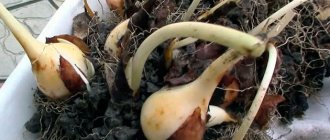Lilies are wonderful garden flower plants due to their ease of care. But there is a paradox here - care may seem difficult for some gardeners.
This is partly due to the capriciousness of growing lilies - when planted correctly, they are unpretentious, but require attention at certain moments of the summer season.
One of these is the autumn period after flowering. In the article we will analyze the timing and need for pruning lilies, the procedure and subsequent care.
Should lilies be pruned for the winter?
Cutting lilies for the winter in the fall is not only possible, but also necessary. There are several subjective and objective reasons for this.
- One of them is purely aesthetic. The flowerbed with yellow dried stems and leaves looks extremely unkempt. Especially if varieties with early flowering periods were planted in a composition with flowers whose flowering period occurs in autumn.
- The second is preventive in nature. It’s good if the stems simply dried out by autumn. But in rainy and cool weather they begin to rot or become affected by fungal diseases. This means that the risk of infection of the bulbs increases. Damaged tubers have a small chance to survive the winter and show their beauty next season.
- Dense foliage, especially in tall varieties, is an excellent winter habitat for pests and harmful microorganisms.
- Flowers with cut stems are much better able to withstand replanting, dividing nests and other manipulations in the fall. After all, their bulbs have time to ripen. They accumulate a sufficient amount of organic and mineral substances, which otherwise would be used for the formation of seeds.
It is worth keeping in mind that lilies that are grown not for cutting, but for decorating garden plots, are usually cut twice in the fall.
Should lilies be trimmed after flowering?
After the end of flowering, without waiting for the lilies to be pruned before winter, experienced gardeners recommend cutting off all the flower stalks, or rather the seed pods. The fact is that at the height of the growing season, the bulbs lose a large amount of nutrients and weaken. They need to gain strength for the upcoming cold weather.
What to do with the bulbs
They can be dug up, or they can be left in the ground for the winter. It depends on the region of residence. If winters are mild, then a layer of soil and fallen leaves is enough to protect them from the cold. If winters are harsh, then varieties that are afraid of frost must be removed. These include trumpet lilies. They are so delicate that at very low temperatures no external coating will save them.
Trumpet lilies
The dug up bulbs are cleaned of children, sorted and stored in a dry cellar or refrigerator. It is better to transplant trumpet lily bulbs from open ground into flower pots and store them in the basement.
So. The tenderness and demanding nature of lilies forces flower growers to treat them with special respect and attention. It is important for lovers of these flowers to remember that they need to be cared for not only during the flowering period, and the stems should be trimmed after flowering no earlier than their natural wilting. Following simple rules will be rewarded with an abundance of flowers on the plants next summer.
If you find an error, please select a piece of text and press Ctrl+Enter.
When to cut lilies in autumn for winter
Even an experienced gardener will not undertake to name the exact time frame for pruning lilies in the fall. Much depends on the timing of their flowering and weather conditions. In years with early warm spring, some varieties are ready for pruning in the second half of August.
As a rule, lilies are cut for the winter during September. By this point, most varieties have finished their growing season, and most importantly, the process of photosynthesis, thanks to which particles of oxygen and nutrients reach the bulb.
Here it is worth focusing on several points. The trunk of the plant should turn yellow, and the leaves should completely wither, or, best of all, dry out. There is no point in pruning lilies prematurely for the winter for a simple reason. Bulbs receive nutrition not only through the root system, but also through the foliage.
Attention!
By cutting off green stems, gardeners deprive it of additional minerals. This inhibits the growth and maturation of the bulbs. It will be difficult to wait for abundant flowering from weakened plants next season. Moreover, they can die during frosts.
Timing for pruning lilies for the winter in the Moscow region and regions
Under standard weather conditions in the middle zone, without anomalies such as hot or cold summers, the time for pruning and preparing lilies for winter in the Moscow region falls in the second half of September. In the northwestern regions this is the end of September, beginning of October. This is due to the fact that lilies sprout and bloom in cool climates somewhat later. In the Urals and Siberia, as a rule, Asian varieties with early flowering periods are grown. They bloom at the end of June or the first half of August. Here it is necessary to prune the lilies at the beginning of the first month of autumn, before the onset of cold weather, in order to have time to carry out other activities to prepare the lilies for wintering.
The main mistakes of novice flower growers
Inexperienced gardeners often make the following mistakes:
- they forget about autumn feeding, which is very important for plants;
- cut foliage and stems early or leave them unpruned;
- do not dig up the bulbs, leaving the babies on the mother bulb;
- the plant is not properly covered for the winter;
- bulbs of frost-sensitive varieties are left in open ground for the winter;
- They do not comply with the deadlines for removing covering material from lilies in the spring.
If autumn events are carried out correctly, the plants will thank you with active flowering in the summer.
Caring for lilies in the fall after pruning
The worries don't end with pruning lily trunks in the fall. Flowerbeds are sprayed with solutions of antifungal drugs. You can use “Fitosporin”, “Hom” or a 1% solution of copper sulfate. They treat both plant remains and the soil underneath them.
Such preventive treatments will help protect the bulb from dangerous diseases, not least of which is fusarium. This is a particularly dangerous disease that often leads to the death of lilies.
After pruning, lilies are not watered. In case of heavy rains, the plantings are covered with cardboard or film so that moisture does not flow down the remaining parts of the trunks to the bulb.
It is advisable to fertilize between the first and second pruning. A solution of superphosphate or potassium salt is used. Organic fertilizers are not recommended because they stimulate foliage growth.
If for some reason it was not possible to feed the lilies on time, you can do this after the final pruning. During this period, it is already possible to add dry compost or humus to the loosened soil. In the spring, as the snow melts, nutrients will reach the awakened bulb.
In regions with cold winters, plantings are covered with a layer of peat mulch containing sawdust or spruce needles.
You can learn how to properly prune lilies for the winter from the video.
How to trim flowers before replanting
When to prune irises after flowering
Lilies can grow in one place for up to 3-5 years. The bulb of this plant quickly produces babies, as a result of which the flowers become smaller. Then it’s time to prune and replant the lilies.
There are two transplant options: in spring or autumn. If further planting is planned for spring, the stems should be trimmed after wilting, leaving 10-15 cm from the ground. This is about a month after complete flowering. Before digging, cut off the remaining part. The bulb should be dug up in September-October, as late as possible after flowering.
The optimal time for transplantation is autumn. In this case, you need to cut the stems at ground level and dig up the bulbs a month after the plant wilts. Then dry the bulbs for 1-2 days, clean them of dry scales, disinfect them in a weak solution of potassium permanganate and plant them in previously prepared soil.
How and what to feed lilies after flowering
You can feed with phosphorus-potassium fertilizers (nitroammophosphate, potassium monophosphate). Fertilizers. where nitrogen is contained will provoke the growth of green mass, but we do not need this. Fertilizing with organic fertilizers (humus, vermicompost, compost, slurry solution) will also be useful.
When feeding with organic matter, remember that the bulb does not have a dense shell. To prevent burns, the solution should be weaker, about 2 times.
Photo: Apply fertilizer after the lilies have bloomed
Preparation for winter and storage
You can preserve the bulbs at home until spring planting by properly preparing and placing them. After complete drying, they are rolled in wood ash, but it is also possible to treat them with dry antifungal powder and wrap each bulb in paper or 2 layers of newspaper. Next, the material is placed in a wooden box with ventilation perforations, sprinkled with wood shavings or covered with moss.
There are other storage methods.
- Lilies can be placed in a polyethylene bag with peat, the layer of which is at least 15 cm. The bulbs are placed at a distance of 10 cm from each other, they should not touch. The bag is tied, with several holes made in it for ventilation, and placed in a cardboard box.
- Plants are planted in peat containers or flowerpots. This method is practical: in the spring, when the weather is warm, you need to take the container to a bright place and water the ground so that the bulbs begin to grow.
During storage, it is important to adhere to the optimal temperature regime and ensure that the air is not too humid - because of this, the bulbs can rot. But the indoor climate should not be dry either - this causes dehydration and wrinkling of plants.
Regular ventilation is the key to ensuring that lilies do not get sick and mold does not appear on them. Therefore, it is not recommended to store the bulbs in the refrigerator, as some of the planting material may be irretrievably damaged.
Plants left in the ground need 10-15 cm of snow to survive the cold
But in winters with little snow, it is important to use mulching with coniferous branches, leaves, and peat. The coating is removed when the ground thaws.
Hybrid and Asian varieties of lilies require special storage. A ditch is dug in the garden and drainage material is placed at the bottom. You need to make a lid for it and line the interior with boards. Prepared bulbs in bags or boxes are placed in a trench and transferred with bags of water. This allows you to soften temperature changes inside the shelter. The storage is covered with a film, and on top - with a lid, on which spruce soil, pine branches and cardboard are poured.











